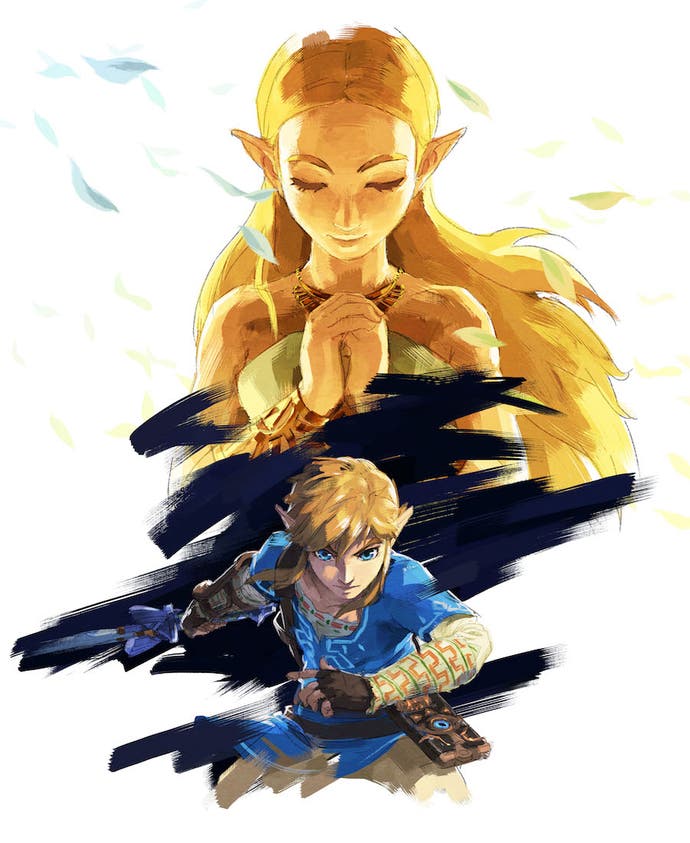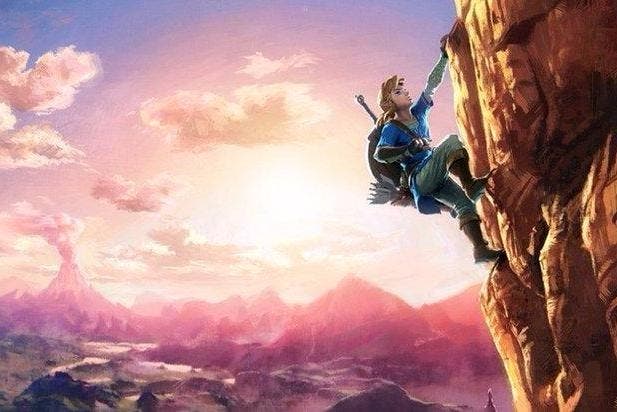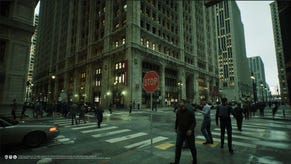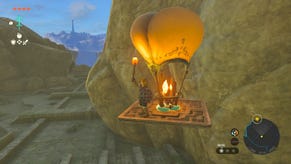The Legend of Zelda: Breath of the Wild review
Fresh air.
Here's an unusual admission for a reviewer to make. I haven't finished The Legend of Zelda: Breath of the Wild. I've yet to uncover swathes of its vast map. Much remains for me to do and discover, and my game is still rife with rumour, mystery and surprise. This is partly because my life is no longer compatible with monstering a giant open-world game in a week, even when it's work. But it's also because of the kind of game that Breath of the Wild is.
The reason I feel comfortable telling you this is that this isn't a game that any one player can just know. You can map it out, sure - spend weeks or months enumerating all its components and secrets. But the game's magic resides in its combination of sheer size with sheer openness, with apparently freewheeling yet meticulously interlocked systems, and with a scarcely credible level of detail and craft in its making. When a game world like this meets players, alchemy happens. My meandering and half-complete run, full of digressions and doubling back, feels as meaningful as the game of a completist, or of a player who skipped the main quest to take a run straight at the end boss with armour and weapons scavenged from the map's darkest corners, or a player who chose to ignore the storyline altogether in favour of unlocking the mysteries of Hyrule's most elusive Shrines, or of a player who simply headed north to see what lay there. Rarely has a game been so tempting to restart while you were still playing it.

Our hero Link awakes on a high plateau in the middle of Hyrule's rugged vastness. Sheer cliffs drop off all around, which conveniently confines us here until we've learned the ropes and earned the paraglider that will guide us safely down to the world below. But those cliffs are also there to give us an unhindered and honestly breathtaking view over the world we're about to explore, from cursed castle to hazy wetland, boiling volcano to parched desert. Amid the misty watercolour washes of this fantasy landscape, you can pick out the sharp glow and alien forms of ancient Sheikah technology: towers that fill in the map, and Shrines that house combat tests and physics puzzles. It's an incredibly promising view, and not a misleading one. Nintendo's first open world is up there with Azeroth and San Andreas as one of the greatest game worlds ever created.
Link, it turns out, has been asleep for 100 years, having failed with Zelda to defeat the apocalyptic evil known as Calamity Ganon. Ganon is contained at Hyrule Castle - as is Zelda - but it's up to Link to take a second stab at him. If he wants help, he must journey to the four corners of Hyrule to rehabilitate the Divine Beasts, giant mechanical creatures originally created to defeat Ganon that have now run amok. This is what you would consider the meat of a regular Zelda game - yet, while strongly advised, it's entirely optional.
On your travels you will meet the charming and familiar tribes of Hyrule: the aquatic Zora and avian Rito, the tubby rock-munching Gorons and the fierce Gerudo matriarchy which excludes all men from its desert city. The Korok - cute, rattling woodland sprites that first appeared in The Wind Waker - are here too, and they are vital to the tapestry of Breath of the Wild. But you won't be guided to their well-hidden homeland by any quest marker; you'll have to follow rumours and suggestions to find it and know its importance. That is as good an example as any of the remarkable confidence Nintendo's developers have in their world to draw players in, and the trust they have in those players to explore it freely and inquisitively. Few games in this waypoint-infested genre have that courage.

You'll also learn about the Sheikah tablet you're carrying, a sort of fantasy iPad that summons bombs and ice blocks, and commands the forces of inertia and magnetism. Although you can upgrade it, its core abilities are all unlocked by the time you leave the starter area. Gear-gating - using the acquisition of new items to manage the player's progress through the game - is one of many 30-year Zelda traditions that Breath of the Wild bravely discards, in favour of giving you pretty much all the tools early on and sending you off to find your own path. Bombs aside, the power-ups you get aren't the ones you're expecting, and they upgrade in unpredictable ways, branching off in new directions rather than simply getting stronger.
You'll also learn more about what happened 100 years ago (Link is an amnesiac, of course) in a series of cutscenes. If Breath of the Wild has one weakness, it's as a story. The grand events of the past seem remote from the teeming world around you, not to mention rather hackneyed, while the English voice acting - sparingly used, thankfully - is stiff and cheesy. Unlike such soulful adventures as Ocarina of Time and Majora's Mask, Breath of the Wild isn't unduly interested in ordinary people and their stories, and it musters neither the poignant little vignettes nor the strong emotional tenor of those games. It doesn't have the memorable characters and simple, pure narrative purpose of The Wind Waker, either. It's a shame - but it doesn't need these things.
Arguably, a stronger storyline wouldn't have been compatible with Nintendo's decision to grant the player so much freedom. You really don't get this level of openness anywhere else this side of a Bethesda role-playing game. (The Elder Scrolls 5: Skyrim is an obvious inspiration.) You can do whatever you like, and go wherever you feel, greatly assisted by Link's ability to climb almost any surface. This is a game that wholly rejects artificial barriers. The further away you get from the centre, the stronger monsters are, but there's no grind to meet their level and the means to match them can be found just through exploring. Breath of the Wild also rewards your curiosity with constant and dazzling inventiveness. It's dumbfounding that such a vast space should be so packed with things to find, observe and do.
The designers are squarely focused on keeping you out in this world, and for Zelda traditionalists, that means one major and potentially painful casualty: dungeons. There isn't anything you would describe as a classic Zelda dungeon here, no huge and devious labyrinth of locks and keys, boss fights and puzzles. The gameplay survives in the Shrines, which house the cleverest puzzles in chambers tinged with Portal's austere lab aesthetic, and out in the world, where boss monsters roam and elaborate combat gauntlets await. The Divine Beasts are relatively compact but extremely intricate and rewarding challenges that are probably the closest thing to a dungeon per se. Some Shrines take much longer to complete than others, and are introduced by involved and mysterious quest lines.
Underpinning the whole game is an extremely strong and multifaceted suite of linked systems, including weather, stealth, cooking, and a fantastically fun and convincing physics simulation. (Even item drops from enemies are fully physically modelled.) Cooking, which provides useful buffs as well as refilling your health, isn't the recipe list you'd expect; it's a system where the same dish can be conjured from different ingredients and at different potencies. It's not about collection or rote learning, it's about understanding the rules and then improvising with what you have.
This is true of the game as a whole, especially in combat, where all Breath of the Wild's tools and systems meet. There are so many variables in a fight - what you happen to be holding, what your enemy is holding, if there are any fires or boulders around, if you're in the eye of a lightning storm and so need to unequip everything metal - that it's almost always better to wing it and try new tactics on the fly than to settle into a groove. This is a game that can play like Dynasty Warriors one minute and Metal Gear Solid the next.
Food buffs can help you out hugely if you're under-equipped - and being over-equipped isn't always a good thing. Breath of the Wild's disposable weapons may prove to be the most controversial aspect of its design; weapons wear out fast, and only a few very special ones can be repaired. You're even encouraged to throw them away as they get worn down, as a well-placed lob will earn you a critical hit. It starts out stressful, but it's ultimately a liberating change that's reminiscent of Halo's weapon-swap philosophy. It also has brilliant consequences for Breath of the Wild's sweeping reinterpretation of role-playing game convention.
With no experience points to grind, Link's progression is entirely dictated by gear: clothes for defense and weapons for attack power. A great weapon find is doubly precious for being temporary, so you won't want to waste its short life on weak enemies, and it's always good to have one or two lesser pieces on hand. Thus you're voluntarily scaling your power to the situation at hand, which makes you feel smart and still gives you a strong sense of advancement, without the deadening effect of a level-balancing set-up such as Skyrim's. (Plus, all the equipment looks really cool, and collecting and upgrading Link's outfits is quite compulsive.)
What this all adds up to is superb sandbox game design, free of fiddle or bloat, unencumbered with preconceptions, and executed with the rock-solid reliability, tactile feedback and arcade brio for which Nintendo is justly celebrated. In other words: a total marvel.
In case it isn't clear, this is a very different Legend of Zelda game. Until very recently, Nintendo has made its games in a bubble - not that this was necessarily a bad thing, as its priorities were unique, and its standards were uniquely high, but it seemed quite unconcerned by what other game makers were up to. Zelda, one of the most widely admired, finely honed and carefully iterated designs in gaming, was a bubble within this bubble. Its recurring plots about the hero in green echoed its well-worn, smooth patterns of play: get the boomerang, hookshot and bombs, do the dungeons, save the girl. It was a ritual incantation, a myth that ticked like clockwork.
All that has been either swept aside or remade from first principles. It's hard to overstate the courage and conviction with which producer Eiji Aonuma, director Hidemaro Fujibayashi and their team have rewritten their own work, and the size of the risk Nintendo has taken with a beloved property. Breath of the Wild isn't just the most radical departure from the Zelda tradition in its 30-year history, it's the first Nintendo game that feels like it was made in a world where Half-Life 2, Halo, Grand Theft Auto 3 and Skyrim happened. It's inspired by those greats and others, but it doesn't ape them any more than it rests on its own laurels. And if we're talking inspirations, we have to recognise one game above all others, an uncompromising adventure from 1986 that dared to take gaming off the rails, that put a whole world beyond the TV screen and invited the player to explore it: the original Legend of Zelda.





















